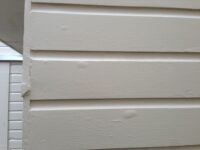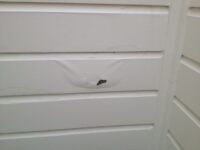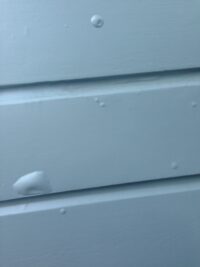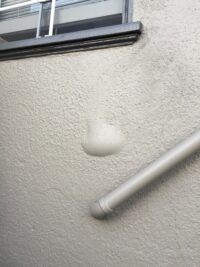PAi of exterior paint coating is usually caused by moisture in the substrate (wood siding, stucco, etc.) Moisture bubbles, unlike heat blisters, will go through all coats of paint down to the substrate.
Under normal conditions, water will want to evaporate. If water is in the substrate, and it doesn’t have any coating on it, it isn’t a problem. It will just evaporate — dry out. However, if the paint coating gets in the way of water trying to evaporate, the water vapor, unable to penetrate it, will put enough pressure on this coating to force it away from the substrate creating a bubble.
To stop moisture bubbles, you must find and eliminate the source of moisture intrusion.
Roof and gutter leaks, leaky windows and lack of proper flashing are all usual suspects in leak detection. Improper construction technique, unsealed wood end-grain, uncaulked vertical joints and seams around widows and doors can all allow rain water to enter the substrate and cause paint to bubble.
Likewise, moisture moving through a wall, from inside home to the exterior paint, can come from plumbing leaks, sinks and tub overflows. These shouldn’t be ruled out as possible culprits.
Moisture vapor from hot showers, cooking, damp basements and use of humidifiers can all be the cause of excessive moisture in substrate. If there isn’t any vapor barrier, or if the barrier is incorrectly installed, the vapor can easily move through exterior wall and cause paint bubbling. Suspect this if you find bubbling on the outside of bathrooms, laundry rooms and kitchens. Improve ventilation (install fens, open windows, etc.) and consider strategic use of dehumidifiers.
Paint bubbling outside of bedrooms often puzzles homeowners and professional painters alike. This is because there seems to be no obvious source of moisture. Well, let’s take a closer look. On average, a person loses about 28 ounces of water, due to respiration and perspiration, per 24 hour period. This brakes down to about 9.5 oz. per night (8 hrs.) per person. What happens with all of this moisture?
As sun comes up in the morning and outside temperature rises, this moisture will want to evaporate, and some of it will find its way to the back of your exterior paint coating. The hotter the surface temperature the stronger the push to evaporate, the more likelihood of bubbling.
Here is a paint tip: use lighter paint colors whenever possible. The lighter the surface color the more of sun light energy is reflected from it. The darker the color, the more sunlight energy is absorbed by the surface and the hotter it gets. This is why choosing a light exterior color can help with the paint bubbling problem, and will generally extend the life span of a paint job.
Paint substrate has to be able to “breathe”. That is, it has to be capable of releasing moisture it has absorbed. Proper venting and free to move expansion joints (as in case of wood siding) are all very important for this reason. But vents are often missing all together (or are plugged by caked-on paint) and expansion joints are often caulked shut by over-zealous homeowners and amateur painters. This can result in moisture being trapped in the substrate.
Paint coating itself is generally breathable. That is to say, it is capable of allowing moisture vapors to pass through it. However, after a home has been repainted five or ten times it can have ten or twenty coats of paint on it. This can bring the breathability of paint, and the substrate it is coating, to near zero. This is why you can often solve a persistent paint bubbling problem by stripping all of the old coating from a substrate before repainting.
In a situation where the substrate has lost most of its ability to breathe, even a very small amount of moisture entering it can build up and result in paint bubbling.
Please also keep in mind that a perfectly dry and suitable for painting wood will have between 6 and 15 percent moisture content. So, even if the surface has never bubbled before, just by decreasing its breathability (through adding coats to already heavy paint build up) and/or raising surface temperature even by just a few degrees (due to a darker color paint used) you can cause paint to start bubbling.
So, let’s recap. To deal with moisture caused bubbles one has to:
1) Detect and eliminate sources of water intrusion (leak detection)
2) Handle excess moisture generated inside a home (increase of ventilation and use of dehumidifies)
3) Increase the substrate breathability (improve exterior venting and/or old paint stripping)
4) Reduce surface temperature (use lighter paint colors)
I hope this helps.
Yefim Skomorovsky
Painting Contractor in San Francisco Bay Area





Articles
- Key to Getting the Best Deal on a Painting Job
- How to Evaluate Painting Proposals
- How to Select the Best Painting Contractor
- Importance of Paint Surface Preparation
- Steps for Paint Surface Preparation
- Why Paint Bubbles
- How to Evaluate Quality of Paint
- Introduction to Paint Colors
- More About Paint Colors – The Color Wheel
- Color Scheme Building
- Color Computer
- Painting a Victorian
- Customer Satisfaction and Customer Service
- Maintaining Your New Exterior Paint Job
- Maintaining Your New Interior Paint Job
- Fall House Maintenance Checklist
- Contractor’s Resume
Comments on “Why Paint Marshal”